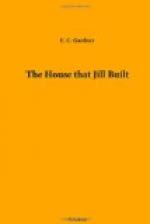SAFE FLUES AND MORE LIGHT.
By a tender but vigorous application of the remedies usual in such cases, Jack was speedily restored to his wonted equanimity, and Jill, laying Uncle Harry aside, took up the architect’s suggestions concerning the plumbing, which referred rather to its relations to the plan of the house than to the details of the work itself.
“A bath-room, with all the plumbing articles it usually contains, must possess at least three special characteristics. It must be easily warmed in cold weather, otherwise the annual bill for repairs will be greater than the cost of coal for the whole house; its walls, floors and ceilings must be impervious to sound. The music of murmuring brooks is delightful to our ears, so is the patter of the soft rain on the roof; but the splashing of water in a, bath-tub and the gurgling of unseen water-pipes are not pleasant accompaniments to a dinner-table conversation. Thirdly, it must be perfectly ventilated—not the drainpipes merely,—but the room itself in summer and in winter. Two of the above conditions can best be secured by arranging to have this important room placed in a detached or semi-detached wing; and here begin the compromises between convenience, cost and safety. It is convenient to have a bath-room attached to every chamber, and there is no doubt that this may be done with entire safety, provided you do not regard the cost. In your plan I have adopted the middle course. There is one bath-room for all the chambers of the second floor, not too remote but somewhat retired, and having no communication with any other room. It is ventilated by a large open flue carried up directly through the roof; it has also an outside window and inlets for fresh air near the floor. All the walls and partitions around it will be double and filled with mineral wool, and the floors will be deafened. The ’house side’ of the water-closet traps will have three-inch iron pipes running to the ventilating flue beside the kitchen-chimney, a flue that will always be warm, and therefore certain to give a strong upward draught at all times, which cannot be said of any other flue in the house, not even of the main drain, or soil-pipe, which passes up through the roof. It would be easy to keep other flues warmed in cold weather by steam-pipes, but in summer you will have no steam for heating purposes. A ‘circulation-pipe’ might be attached to a boiler on the kitchen range for this purpose, but in the present case such a contrivance would cost more than the iron pipe carried from the bath-room to the flue that is warmed by the kitchen fire. A good way to build this ventilating flue is to inclose the smoke-pipe from the range, which may be of iron or glazed earthen pipe, in a larger brick flue or chamber (Fig. 1), keeping it in place by bars of iron laid into the masonry. The rising current of warm air around the heated smoke-pipe will be as constant and reliable as the trade winds. It will be well, indeed, if all your chimneys are




